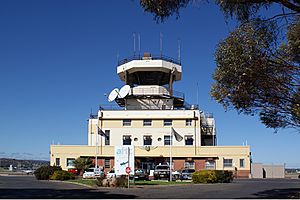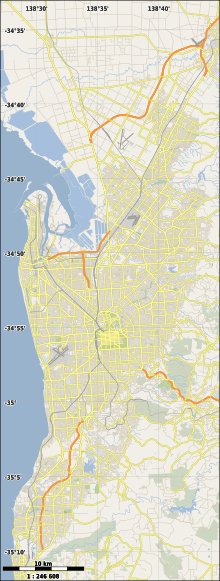Parafield Airport facts for kids
Quick facts for kids
Parafield Airport
Adelaide–Parafield
|
|||||||||||||||||||||||
|---|---|---|---|---|---|---|---|---|---|---|---|---|---|---|---|---|---|---|---|---|---|---|---|
 |
|||||||||||||||||||||||
| Summary | |||||||||||||||||||||||
| Airport type | Public | ||||||||||||||||||||||
| Owner | Government of Australia | ||||||||||||||||||||||
| Operator | Parafield Airport Limited | ||||||||||||||||||||||
| Serves | Adelaide | ||||||||||||||||||||||
| Location | Parafield, South Australia | ||||||||||||||||||||||
| Elevation AMSL | 57 ft / 17 m | ||||||||||||||||||||||
| Coordinates | 34°47′36″S 138°37′59″E / 34.79333°S 138.63306°E | ||||||||||||||||||||||
| Map | |||||||||||||||||||||||
| Runway | |||||||||||||||||||||||
|
|||||||||||||||||||||||
| Statistics (2010/11) | |||||||||||||||||||||||
|
|||||||||||||||||||||||
|
Sources: Australian AIP and aerodrome chart, Movements from Airservices Australia
|
|||||||||||||||||||||||
Parafield Airport (ICAO: YPPF) is a public airport in Parafield, South Australia. It is about 18 km (11 mi) north of Adelaide city. This airport is mainly used for training pilots and for small planes.
Parafield Airport was the only civil airport for Adelaide until Adelaide Airport opened in 1955. Today, it is a busy place for learning to fly. It is also home to the University of South Australia Aviation Academy. You can even find a museum with old jet fighters and historic aircraft here!
Many flight schools operate at Parafield Airport. These include the University of South Australia Aviation Academy and FTA (Flight Training Adelaide). The Australian Air League, a group that helps young people learn about aviation, also has a squadron here. Parafield Airport is Australia's busiest airport when it comes to the number of aircraft movements. In 2020, it handled 272,646 aircraft movements.
Contents
History of Parafield Airport
How Parafield Airport Started
The very first powered flight in South Australia happened on March 13, 1910. It was a Blériot Aéronautique monoplane flying near Salisbury, South Australia. In the 1920s, people started looking for a place to build an airport in Adelaide.
The government bought land at Parafield in 1927. This area was once used for farming. On October 1, 1927, a pilot named Horrie Miller was the first to land a plane at the Parafield site. The airport officially opened in August 1929. The control tower was built just before World War II.
Parafield During World War II
During World War II, the Royal Australian Air Force (RAAF) used Parafield Airport. It became a base for basic flight training. No. 1 Elementary Flying Training School RAAF was located here from 1939 to 1944.
Another group, No. 34 Squadron RAAF, used Parafield to deliver supplies. They flew to other airbases in the Northern Territory and Western Australia. After the war, major airlines like Australian National Airways moved to Adelaide Airport in 1955.
Changes Over the Years
In 1983, some local high school students planted trees at the airport. When these trees grew, they spelled out "PARAFIELD" when seen from above. However, these trees were removed by 2007.
New runways opened in May 1992. In May 1998, the airport was sold by the Federal Airports Corporation. It was bought by a group of companies. The Parafield Airport Air Traffic Control Tower is now listed as an important heritage site in Australia.
Classic Jets Fighter Museum
Parafield Airport is home to the Classic Jets Fighter Museum. This museum started in the 1980s. It has a collection of cool old planes, including a Lockheed P-38 Lightning and a Bell P-39 Airacobra. It also has a real, working CAC Wirraway plane.
Airport Noise and the Community
Sometimes, people who live near the airport complain about noise. This is especially true when flight schools are busy. More planes flying means more noise for the nearby homes.
Safety Incidents at Parafield Airport
Even though flying is very safe, sometimes small incidents happen.
- In 2018, a small Cessna 172 plane crashed into a field next to Parafield Airport. The pilot had problems right after taking off. Luckily, no one was hurt in this incident.
- On March 17, 2013, a replica of a Supermarine Spitfire plane crashed near the airport. This happened during an airshow. Sadly, the pilot did not survive.


